The resilience of zebras is one of the factors that make them among the best herbivores for self-defense in the wild.
Video: Maasai Sightings.
The video filmed in the Maasai Mara National Reserve (South Africa) showcases the extraordinary efforts of a zebra facing off against a hyena – a notoriously fierce and tenacious predator of the savanna.
At the start, the hyena has a highly advantageous position, clamping down on the zebra’s hind leg and attempting to bring the animal down.
If it were an antelope, such an attack would likely have resulted in it collapsing. However, the zebra’s strong will and resistance enable it to remain upright, despite suffering a significant injury.
In a disadvantaged position, the zebra tries to defend itself by twisting its head back and biting the hyena’s back.
Although this is not enough to deter the predator, the zebra’s efforts seem to make the hyena loosen its grip, reducing the pressure it was applying.
Seizing the opportunity, the zebra springs into motion, eventually breaking free from the hyena’s control.

Zebras are herbivores, but they are not easy prey.
The resilience of zebras is one of the key elements that helps them become one of the best self-defending herbivores in nature. However, when discussing survival skills, one cannot overlook their distinctive black and white stripes.
According to some studies, these stripes help solitary zebras camouflage better in the grass by breaking up their body shape. This makes it difficult for predators like lions and hyenas to clearly see zebras from a certain distance.
When moving in a herd, the stripes serve another purpose, creating an “optical illusion” that confuses observers, making it hard for them to select a target.
Additionally, zebra stripes are also utilized to cool their bodies under the harsh sun. The reason is that air moves faster through the black stripes that absorb light, while it moves slower through the white stripes.
This creates a convection current around them, helping zebras feel cooler. One study even indicated that zebras with more stripes tend to live in hotter environments.
Unfortunately, modern human activities significantly impact zebra populations, as they have been and continue to be hunted for their skin and meat. In some rural areas, zebras also compete for food with livestock, leading to them being killed for this reason.
Notably, the Cape Mountain Zebra has been hunted to near extinction, with fewer than 100 individuals recorded in the 1930s. Thanks to conservation efforts, this population has increased to about 700 individuals, yet it still faces a very high risk of extinction.


















































